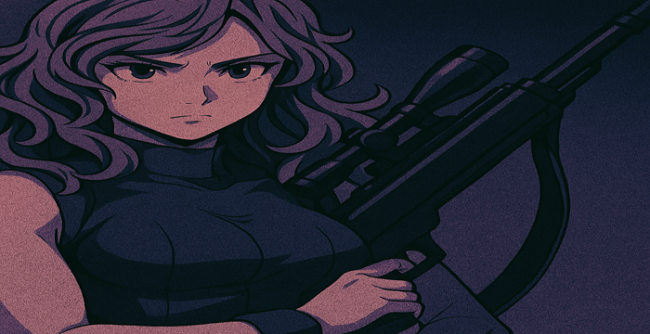Reviews
5 min read
Lady Nagant—The Hero Who Became a Killer: A Deep Dive into My Hero Academia’s Most Complex Villain


Some villains aren’t born evil—they're created. That’s what makes Lady Nagant such a standout character in My Hero Academia (MHA). She’s not your typical anime antagonist. She’s a fallen hero, a disillusioned soul, and possibly the most complex villain the series has given us.
In this post, I’m diving deep into who Lady Nagant is, why she matters, and what makes her arc unforgettable.
Lady Nagant is a character from the manga and anime My Hero Academia. She is a former hero turned villain who plays a key role in the series' "Paranormal Liberation War" arc. She was introduced in My Hero Academia Season 6, Episode 20. Her Quirk, Rifle, turns her arm into a long-range weapon, allowing her to fire customized bullets made from her hair.
She was once hailed as a model hero but became disillusioned after years of being used as a government hitwoman. According to My Hero Academia Wiki, her story begins not with villainy, but with betrayal.
But how did a top-tier hero become one of the most feared assassins in the series? Let’s look into her fall from grace.
During her time with the Hero Public Safety Commission, Lady Nagant was ordered to kill in the name of peace. From eliminating dissenters to silencing internal threats, she was asked to uphold a facade. The pressure and trauma finally broke her when she murdered a fellow hero on duty, marking her as a traitor and landing her in Tartarus prison (CBR).
Her story exposes the dark underbelly of the hero society, where maintaining order often comes at the cost of morality.
This depth of moral conflict makes her unlike any other villain we’ve seen before. So, what exactly sets her apart?
Unlike characters driven by ego or chaos, Lady Nagant acts out of ideological collapse. She doesn’t trust heroes—or villains. Her belief is that the entire system is flawed. That puts her in the same category as characters like Stain and Hawks, but with even more emotional depth.
Screen Rant argues that she’s less of a villain and more of an anti-hero—someone who lost faith but still fights for what she thinks is right.
This identity crisis is reflected in everything about her, including how she looks and fights. Let’s explore the symbolism behind her character design.
Lady Nagant’s design with a weaponized arm represents how she was transformed into a tool, and her hair bullets show how even something organic and beautiful can become lethal when manipulated. Her color scheme—purples and muted pinks—suggests emotional distance and hidden pain.
Her Rifle Quirk isn't just practical; it's poetic. Every shot is controlled, precise, and emotionally loaded—just like her mindset. Fans on Reddit note that her combat style reflects the emotional precision of someone trying to keep their guilt in check.
And all of this culminates in one of the most impactful confrontations in the series—her battle with Deku.
This fight isn’t about power levels. It’s about morality. Lady Nagant challenges Deku's view of heroism, asking, "What if the people you save are the ones destroying others?" Their fight becomes a debate, with Deku representing idealism and Nagant representing realism.
During this encounter, Deku doesn't try to destroy her—he tries to understand her. Crunchyroll explains how this fight shapes Deku’s shift into his “Dark Hero” phase, emphasizing responsibility over blind optimism.
But what happens after she loses? That’s where her story becomes even more layered.
Lady Nagant is critically injured during the battle with Deku (Izuku Midoriya) in the Paranormal Liberation War arc. After a confrontation where she initially tries to kill Deku, she realizes that her ideals and beliefs have been manipulated, and she is ultimately saved by him. In the end, Lady Nagant doesn't die but is taken into custody by the authorities.
Her storyline reflects themes of disillusionment with the hero society and redemption, though her fate remains tied to the larger conflicts in My Hero Academia.
Nagant’s arc mirrors that of real-life whistleblowers and soldiers suffering from moral injury. She’s someone who carried out unspeakable acts for a greater cause, then was abandoned when the truth came out.
CBR notes that Lady Nagant reflects systemic corruption and the psychological toll of being a state agent. Her story is a commentary on the emotional aftermath of blind obedience.
And fans have recognized that depth through their art, theories, and the demand for more of her story.
Lady Nagant has ignited fan communities in a major way.
On MyAnimeList, she's now one of the most searched female villains in recent anime.
Fan artists have flooded social media with stunning renditions of her character, often showing her either broken or serene.
Cosplayers have recreated her look with sniper-accurate detail, while theorists on Reddit speculate about her return or future alliances.
Clearly, her impact goes beyond the screen. But why does she resonate so deeply—and what does she teach us about modern storytelling?
Lady Nagant isn’t just a sniper with a dark past. She’s a critique of power, a voice for the broken, and a challenge to simplistic ideas of good versus evil. Her arc pushes My Hero Academia into deeper, more mature territory.
She asks questions that don’t have easy answers—and that’s what makes her unforgettable.
And with fans hoping for her return and creators teasing unfinished business, her story might not be over yet.
Be the first to post comment!